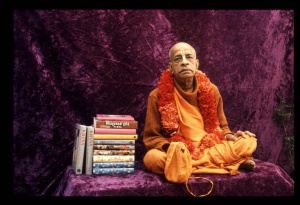CC Madhya 2.79 (1975): Difference between revisions
(Vanibot #0027: CCMirror - Mirror CC's 1996 edition to form a basis for 1975) |
(Vanibot #0020: VersionCompareLinker - added a link to the Version Compare feature) |
||
| Line 2: | Line 2: | ||
<div style="float:left">'''[[Sri Caitanya-caritamrta (1975)|Śrī Caitanya-caritāmṛta (1975)]] - [[CC Madhya (1975)|Madhya-līlā]] - [[CC Madhya 2 (1975)|Chapter 2: The Ecstatic Manifestations of Lord Śrī Caitanya Mahāprabhu]]'''</div> | <div style="float:left">'''[[Sri Caitanya-caritamrta (1975)|Śrī Caitanya-caritāmṛta (1975)]] - [[CC Madhya (1975)|Madhya-līlā]] - [[CC Madhya 2 (1975)|Chapter 2: The Ecstatic Manifestations of Lord Śrī Caitanya Mahāprabhu]]'''</div> | ||
<div style="float:right">[[File:Go-previous.png|link=CC Madhya 2.78 (1975)|Madhya-līlā 2.78]] '''[[CC Madhya 2.78 (1975)|Madhya-līlā 2.78]] - [[CC Madhya 2.80 (1975)|Madhya-līlā 2.80]]''' [[File:Go-next.png|link=CC Madhya 2.80 (1975)|Madhya-līlā 2.80]]</div> | <div style="float:right">[[File:Go-previous.png|link=CC Madhya 2.78 (1975)|Madhya-līlā 2.78]] '''[[CC Madhya 2.78 (1975)|Madhya-līlā 2.78]] - [[CC Madhya 2.80 (1975)|Madhya-līlā 2.80]]''' [[File:Go-next.png|link=CC Madhya 2.80 (1975)|Madhya-līlā 2.80]]</div> | ||
{{CompareVersions|CC|Madhya 2.79|CC 1975|CC 1996}} | |||
{{RandomImage}} | {{RandomImage}} | ||
==== TEXT 79 ==== | ==== TEXT 79 ==== | ||
<div class="verse"> | <div class="verse"> | ||
: | :līlāśuka--martya-jana, tāṅra haya bhāvodgama, | ||
:īśvare | :īśvare se--ki ihā vismaya | ||
:tāhe mukhya-rasāśraya, | :tāhe mukhya-rasāśraya, ha-iyāchena mahāśaya, | ||
:tāte haya sarva-bhāvodaya | :tāte haya sarva-bhāvodaya | ||
</div> | </div> | ||
| Line 20: | Line 19: | ||
<div class="synonyms"> | <div class="synonyms"> | ||
līlā-śuka—Bilvamaṅgala Ṭhākura; martya-jana—a person of this world; tāṅra—of him; haya—there is; bhāva-udgama—manifestation of different ecstasies; īśvare—in the Supreme Lord; se—that; ki—what; ihā—here; vismaya—astonishing; tāhe—in that; | līlā-śuka—Bilvamaṅgala Ṭhākura; martya-jana—a person of this world; tāṅra—of him; haya—there is; bhāva-udgama—manifestation of different ecstasies; īśvare—in the Supreme Lord; se—that; ki—what; ihā—here; vismaya—astonishing; tāhe—in that; mukhya—chief; rasa-āśraya—mellows,; ha-iyāchena—has become; mahā-āśaya—the great personality Śrī Caitanya Mahāprabhu; tāte—therefore; haya—there is; sarva-bhāva-udaya—a manifestation of all ecstasies. | ||
</div> | </div> | ||
| Line 27: | Line 26: | ||
<div class="translation"> | <div class="translation"> | ||
Līlāśuka [Bilvamaṅgala Ṭhākura] was an ordinary human being, yet he developed many ecstatic symptoms in his body. What, then, is so astonishing about these | Līlāśuka [Bilvamaṅgala Ṭhākura] was an ordinary human being, yet he developed many ecstatic symptoms in his body. What, then, is so astonishing about these symptoms' being manifest in the body of the Supreme Personality of Godhead? In the ecstatic mood of conjugal love, Śrī Caitanya Mahāprabhu was on the highest platform; therefore, all the exuberant ecstasies were naturally visible in His body. | ||
</div> | </div> | ||
Latest revision as of 12:32, 27 January 2020

A.C. Bhaktivedanta Swami Prabhupada
TEXT 79
- līlāśuka--martya-jana, tāṅra haya bhāvodgama,
- īśvare se--ki ihā vismaya
- tāhe mukhya-rasāśraya, ha-iyāchena mahāśaya,
- tāte haya sarva-bhāvodaya
SYNONYMS
līlā-śuka—Bilvamaṅgala Ṭhākura; martya-jana—a person of this world; tāṅra—of him; haya—there is; bhāva-udgama—manifestation of different ecstasies; īśvare—in the Supreme Lord; se—that; ki—what; ihā—here; vismaya—astonishing; tāhe—in that; mukhya—chief; rasa-āśraya—mellows,; ha-iyāchena—has become; mahā-āśaya—the great personality Śrī Caitanya Mahāprabhu; tāte—therefore; haya—there is; sarva-bhāva-udaya—a manifestation of all ecstasies.
TRANSLATION
Līlāśuka [Bilvamaṅgala Ṭhākura] was an ordinary human being, yet he developed many ecstatic symptoms in his body. What, then, is so astonishing about these symptoms' being manifest in the body of the Supreme Personality of Godhead? In the ecstatic mood of conjugal love, Śrī Caitanya Mahāprabhu was on the highest platform; therefore, all the exuberant ecstasies were naturally visible in His body.
PURPORT
Līlāśuka is Bilvamaṅgala Ṭhākura Gosvāmī. He was a South Indian, a brāhmaṇa, and his former name was Śilhaṇa Miśra. When he was a householder, he became attracted to a prostitute named Cintāmaṇi, but eventually he took her advice and became renounced. Thus he wrote a book named Śānti-śataka, and later, by the mercy of Lord Kṛṣṇa and the Vaiṣṇavas, he became a great devotee. Thus he became famous as Bilvamaṅgala Ṭhākura Gosvāmī. On that elevated platform he wrote a book named Kṛṣṇa-karṇāmṛta, which is very famous amongst Vaiṣṇavas. Since he exhibited so many ecstatic symptoms, people used to call him Līlāśuka.